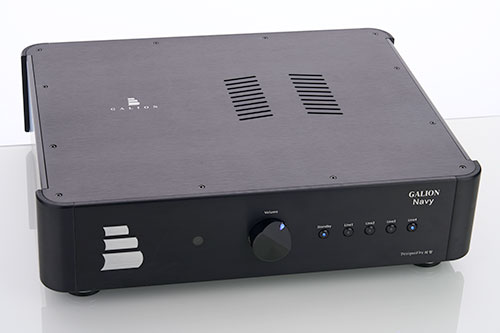Yes, you have already seen above lead picture here recently. But you certainly haven't read the associated new text. This is because Carsten Bussler didn't try out neither the input for the DS Audio cartridges, which operate with two light sources and light-sensitive resistors, nor the headphone output. I'll make up for that now.
Carsten Bussler, actually the tube specialist within the Hifistatement crew, owned a small Stax headphone model for a long time, but then lost sight of the subject a bit, even though his interest was recently rekindled: He currently has two promising representatives of this type of device at home. Of course, I could have sent him one or two headphones from my collection to use with the KECES preamplifier, but he preferred to concentrate on familiar territory and therefore left this aspect of the test to me, as I have been working with this type of transducer for years and also have a comparison object to hand in the form of the SPL Phonitor x.

However, things are a little different with the photoelectric cartridges from DS Audio: None of us have gathered any experience in this field. In view of the fact that DS Audio has officially published the specifications for the required phono equalizers, and more and more electronics specialists are now offering or at least announcing phono amps for this special type of cartridge system, it's time for Hifistatement to take up this topic too. But more on that later. So, let's stay with the KECES headphone output for now. This is designed as a 4-pin XLR socket, which leads to the assumption that there are two balanced amplifier sections feeding it. On the KECES website, there is no specific statement about the headphone output, only the rather generalized statement that the S4 has a "fully balanced design and a large selection of balanced (XLR) and unbalanced (RCA) inputs and corresponding outputs".
In any case, there is not the slightest problem when connecting the Sendy Audio Peacock with its balanced cabling to the KECES - on the contrary. The KECES is connected via the balanced Audioquest Dragon to the digital playback gear in the listening room, specifically to Chord Electronics' DAVE. On the record Ruta And Daitya, "Sounds Of Peru: Submerge / Awakening" would be the first track on the almost unheard second side. That's why I'm now skipping the familiar first four files in the digital version. S4 and Peacock do not only reproduce Jack DeJohnette's strikes on the tablas within a virtual room in a precise and dynamic manner, but also, shortly before Keith Jarrett enters on the grand piano, discloses a slight change within the sonic image. Here the sound engineer has just turned up the controls for the second instrument. Fortunately, even such fine details do not distract from the music itself. On "Algeria", Keith Jarrett switches to the flute and the rhythmic drive of these almost archaic instruments doesn't leave me untouched for a second.
-
Galion Audio Navy Röhrenvorverstärker
Wir haben das röhrenbestückte Vorverstärker-Flaggschiff Navy des jungen kanadischen HiFi-Unternehmens Galion Audio unter die Lupe genommen. Der Line-Vorverstärker mit vier Doppeltrioden 12AT7 (ECC81) wartet nicht nur mit hochwertigen Bauteilen auf, sondern er ist das spannende Designprodukt eines high-fidelen Überzeugungstäters. Mir sagte der Markenname Galion Audio bislang wirklich gar nichts. Das junge Unternehmen aus Québec in Kanada wurde 2020 von Thomas Tan, einem passionierten Audiophilen, YouTuber („Thomas & Stereo“) und Content Creator, gegründet. Ziel war, seine…16.12.2025 -
Eversolo DAC-Z10
Meine beiden D/A-Wandler, der DAVE im Arbeits- und der HUGO TT2 im Wohnzimmer, werden serienmäßig von Schaltnetzteilen gespeist. Bei letzterem kommt seit einiger Zeit ein Ferrum Hypsos, bei Chord Electronics Topmodell ein lineares Dreifach-Netzteil zum Einsatz. Ein solches versorgt auch den Eversolo DAC-Z10 – zum Preis von 2.000 Euro. Und nein, es sind keine drei ausgelagerten Stromversorgungen, für die der genannte Preis gilt. Dafür bekommt man das vollständige Topmodell unter Eversolos DACs. Es ist schon…09.12.2025 -
Raidho X2.6 Standlautsprecher
Mit Lautsprechern von Raidho haben wir uns bei Hifistatement schon öfter beschäftigt. Im Fokus standen dabei die Kompaktlautsprecher TD1.2 aus der TD-Serie sowie X1t und X1.6. aus der X-Serie. Diesmal haben wir den Standlautsprecher X2.6 zu Gast, das aktuell größte Modell der X-Serie. Raidho verspricht, mit der X-Serie besonders viel Leistung – sprich Klangqualität – für den aufgerufenen Preis zu bieten. Wobei, „billige“ Lautsprecher – ganz gleich nach welchem Maßstab - hat Raidho noch nie…02.12.2025 -
Canor Virtus A3
Zur diesjährigen HighEnd stellte Canor den Virtus A3 Hybrid-Vollverstärker vor. Der lockt mit einem integrierten Digital-Analog-Wandler und einer diskret aufgebauten Phono-Vorstufe für MM- und MC-Tonabnehmer. Sowohl seine Technik als auch die Ausstattung bieten Ungewöhnliches. Vor allem aber soll er klanglich beeindrucken. Das slowakische Entwickler-Team konnte mich bereits vor einem Jahr überzeugen: Der Vollverstärker Virtus I2 aus der Premium Line musizierte in meinem Hörraum wie keiner zuvor in dieser Preisklasse. Der war ein gestandener Röhren-Vollverstärker. Auch…28.11.2025 -
Dan D’Agostino Progression S350
Dan D’Agostino ist eine Legende im Verstärkerbau. Er folgte wohl nie einer Mode, sondern vertraut bei allen Entwicklungen seinem Gehör und seiner Leidenschaft für den guten Klang. Mehr als 50 Jahre baut er nun schon Verstärker, immer mit dem Ziel, das „Wesen der Musik hörbar zu machen“. Erfüllt auch der S350 diese hoch gesteckten Ambitionen? Die Progression S350 ist die kleinste Stereoendstufe im Gesamtprogramm. Optisch trägt sie alle charakteristischen Merkmale einer echten D’Agostino. Angefangen mit…25.11.2025 -
iFi Silent Power USB iPurifier Pro & Pulsar USB
Ohne iFis iDefender+ würde das PC-Audio-Setup in meinem Arbeitszimmer überhaupt nicht störungsfrei funktionieren. Dementsprechend ist es für mich eines der besten Tools im Bereich Computer-Audio. Der iPurifier Pro vereint seine Fähigkeiten mit denen eines iSilencer+ und noch mehr Features in einem Gehäuse. Außerdem teste ich das Pulsar USB-Kabel. iFi ist seit Jahren eine Konstante für hochqualitative Audio-Produkte zu fairen Preisen. Zuletzt wurde die Sparte für Stromversorgung, Kabel und Signal-Verbesserer unter SilentPower zusammengefasst. Noch bevor wir…21.11.2025
© 2025 | HIFISTATEMENT | netmagazine | Alle Rechte vorbehalten | Impressum | Datenschutz


























 |
|
















































































